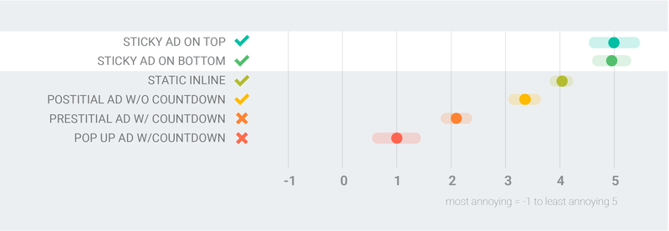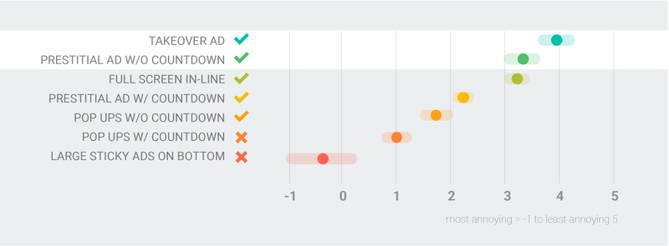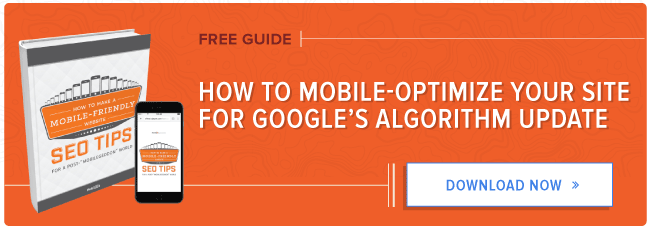
We all know those moments when we stumble upon what looks like a golden piece of content. And just as you’re about to dive in -- an ad appears.
You can’t just close it, either. Before you can get to what you visited that site to see, you have to wait, as a countdown clock in the corner of the ad taunts you with, “Close this ad in 5 … 4 … 3 … ”
At this point, does anyone else just hit the “back” button with an angry mutter of, “Nevermind, I’ll read something else”? That’s because ads like these tarnish your online experience. They keep you from getting to the content you want to see. They’re intrusive. Google knows that -- and now, it wants to prevent that from happening to Chrome users. 
Last Monday, Google announced that it would further crack down on websites that feature intrusive ads like these. And while that might sound great for many, what does it mean for content creators who rely on ad revenue? Don’t panic -- you’re not doomed.
Below, we’ve broken down what marketers need to know about these new guidelines (spoiler alert: Google isn’t doing away with ads altogether), and what you can do to prepare for their rollout.
What's New in Google Ad Blocking
A Better User Experience Without Revenue Loss
To repeat our earlier spoiler, it’s not Google’s intent to do away with ads completely. Rather, the goal appears to be for webmasters to move away from digital ads that interrupt a user’s content consumption -- but not to lose critical ad revenue in the process.
The problem with intrusive ads, writes Google SVP of Ads & Commerce Sridhar Ramaswamy in the official announcement, is that they motivate users to install browser plugins that block ads altogether. And ultimately, that widespread blockage takes “a big toll on the content creators, journalists, web developers, and videographers who depend on ads to fund their content creation.”
Given Google’s algorithmic history, this announcement doesn’t exactly come as a surprise. It’s penalized sites with heavy above-the-fold ad content since 2012, and last year, it announced that mobile sites with intrusive pop-ups wouldn’t rank as well -- both among consistent changes that, at least on the surface, appear to be motivated by an endless quest to improve user experience.
This particular move is largely the result of Google’s partnership with the Coalition for Better Ads, which recently developed Better Ads Standards -- it appears that those standards serve as the foundation for Google’s new ad recommendations to content creators. Once publishers modify their ads to meet the new standards, they can then use Google’s Ad Experience Report to test if they’re in violation of the new standards.
The Penalty
But it’s not entirely clear how, in a broader sense, what the penalty will be for those in violation. The official announcement makes no mention of search ranking implications, though given the search engine’s history within this realm, we wouldn’t be surprised if websites in violation perform as well in search results.
What was clear in the announcement, however, is that within Google Chrome -- which as of May 2017 had just over 63% of global desktop browser market share and 49% on mobile -- the ads in violation of the new standards will be completely blocked. The browser already “prevents pop-ups in new tabs based on the fact that they are annoying,” Ramaswamy writes. Now, Google plans “to have Chrome stop showing ads (including those owned or served by Google) on websites that are not compliant with the Better Ads Standards starting in early 2018.”
The Criteria for "Bad Ads"
Using combined data from its own surveys and those conducted by The Coalition for Better Ads, Google outlined what constitutes a “bad ad” on its DoubleClick blog. Here’s a quick summary of the findings:
- Ads that Interrupt. Remember those taunting countdowns we opened with? That counts as an ad that interrupts: one that “forces you to wait 10 seconds before you can” access the content you want. That’s especially true on mobile, where 74% of users would describe these ads as “extremely or very annoying.”
- Ads that Distract. These are ads with ornate animation or that play loudly, automatically, as or after content loads. As one colleague said to me, speaking for many of us, “Those scare the heck out of me.”
- Ads that Clutter. Many ads also cause a page’s load time to slow down. They’re what Google calls “high-density displays,” and they can make it even longer for users to get to the content they came to a site to see.
Google also created these handy images to show how much “bad ads” annoy mobile users:
 Source: Google
Source: Google
… as well as those on desktop:
 Source: Google
Source: Google
3 Ways to Make Your Ads Better
Within the same DoubleClick post that outlines the worst practices for ad experiences, Google also lists three key elements of the best ones, which content creators can use to guide their revisions:
- Immediate. When ads themselves load quickly, and don’t slow a page’s load time, people tend to engage with them more. Using Google’s AMP framework for advertising can help -- that’s what Time Inc. did, resulting in an increased clickthrough rate, among other measurables.
- Immersive. These are the ads that, in a way, assimilate with the content being viewed, making it less distracting and less likely to interrupt or interfere with the consumption experience. It’s part of what Google calls “native advertising,” in which ads are designed by the publisher of the site where they appear, and not by the advertiser. (Read more about that here.) That way, ads can more seamlessly fit in with your site’s format and purpose.
- Relevant. It’s never been easier to learn more about the people who are consuming your content, by tracking analytics or through simple research. Those are some of the things that comprise “programmatic technology,” Google says, and having that information can help content creators build ad experiences that are relevant to their users. And relevance, we’ve found, correlates with engagement -- maybe that’s why 72% of marketers say creating relevant content was one of their most effective SEO strategies.
The 1 Thing You Should Do Right Now
Remember, Google says that these changes won’t fully take effect until early 2018. With that said, however, it’s never too early to start creating a better ad experience based on the criteria above, and using the tools provided by Google to determine if it meets the new standards.
And again -- the official announcement may not have specifically stated any search ranking implications for those in violation of the new standards, but at risk of sounding like a broken record, Google’s algorithmic history has us suspecting that that could very well be the case.
When all else fails, put yourself in the shoes of a site visitor, and honestly determine if you have any of these responses to your own ad content:
- I don’t care.
- How do I make this go away?
- No. Back to the search results.
- GAH! That ad was LOUD!
- I’m bored.
If any of those thoughts occur to you, then it’s probably time to revisit and re-strategize your ad experiences. We’ll be here to keep you posted on Google’s changes -- and whatever implications come of them for marketers.
Will you change your ad experiences in response to the new standards? Let us know in the comments.

from HubSpot Marketing Blog https://blog.hubspot.com/marketing/google-ad-blocker
No comments:
Post a Comment